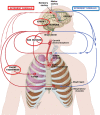DYSPNEA AND MECHANICAL VENTILATION: APPLYING PHYSIOLOGY TO GUIDE THERAPY
- PMID: 37701590
- PMCID: PMC10493724
DYSPNEA AND MECHANICAL VENTILATION: APPLYING PHYSIOLOGY TO GUIDE THERAPY
Abstract
While advances in our understanding of mechanical ventilation have improved mortality from acute respiratory distress syndrome, recent studies indicate a rising incidence of post-ventilation mental health sequelae, including post-traumatic stress disorder (PTSD). Concurrent research on the physiology of dyspnea provides insights about the role of multiple sources of sensory information underlying respiratory discomfort along with the contribution of efferent-afferent dissociation to dyspnea, and the subsequent relationship of dyspnea to a range of affective responses, including fear and anxiety. An understanding of the mechanisms of dyspnea may provide holistic approaches to managing acute respiratory failure that can achieve the best physical and emotional outcomes for patients requiring mechanical ventilation.
© 2023 The American Clinical and Climatological Association.
Figures


References
-
- Mahler, D. A. and, O’Donnell D. E. Dyspnea: Mechanisms, Measurement and Management. Third. CRC Press; 2014. “Neurobiology of Dyspnea: An Overview.”; pp. 3–8.
-
- Schmidt M, Demoule A, Polito A, et al. Dyspnea in mechanically ventilated critically ill patients. Crit Care Med. 2011;39(9):2059–65. doi:10.1097/CCM.0b013e31821e8779. - PubMed
-
- Rose L, Nonoyama M, Rezaie S, Fraser I. Psychological wellbeing, health related quality of life and memories of intensive care and a specialised weaning centre reported by survivors of prolonged mechanical ventilation. Intensive Crit Care Nurs. 2014;30(3):145–51. doi:10.1016/j.iccn.2013.11.002. - PubMed
MeSH terms
LinkOut - more resources
Full Text Sources
Medical
